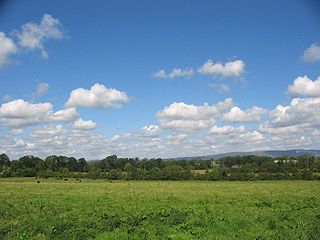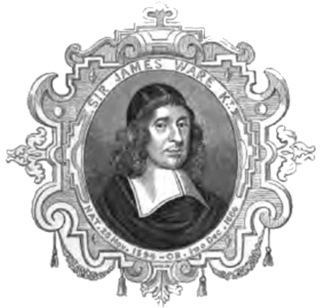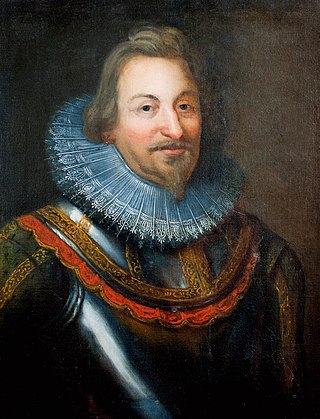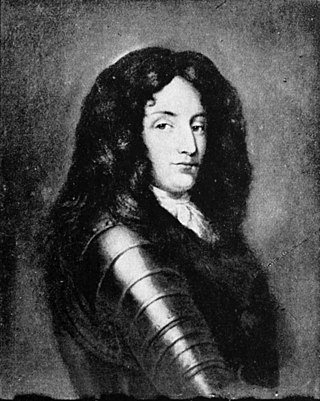Related Research Articles

Sir Phelim Roe O'Neill of Kinard was an Irish politician and soldier who started the Irish rebellion in Ulster on 23 October 1641. He joined the Irish Catholic Confederation in 1642 and fought in the Wars of the Three Kingdoms under his cousin, Owen Roe O'Neill, in the Confederate Ulster Army. After the Cromwellian conquest of Ireland O’Neill went into hiding but was captured, tried and executed in 1653.

The Jacobite peerage includes those peerages created by James II and VII, and the subsequent Jacobite pretenders, after James's deposition from the thrones of England, Scotland and Ireland following the Glorious Revolution of 1688. These creations were not recognised in English, Scots or Irish law, but the titles were used in Jacobite circles in Continental Europe and recognised by France, Spain and the Papacy.

Gerald FitzGerald, 14th Earl of Desmond, also counted as 15th or 16th, owned large part of the Irish province of Munster. In 1565 he fought the private Battle of Affane against his neighbours, the Butlers. After this, he was for some time detained in the Tower of London. Though the First Desmond Rebellion took place in his absence, he led the Second Desmond Rebellion from 1579 to his death and was therefore called the Rebel Earl. He was attainted in 1582 and went into hiding but was hunted down and killed.
James fitz Maurice FitzGerald, called "fitz Maurice", was captain-general of Desmond while Gerald FitzGerald, 14th Earl of Desmond, was detained in England by Queen Elizabeth after the Battle of Affane in 1565. He led the first Desmond Rebellion in 1569 and was sometimes called the "Archtraitor" by the English. He surrendered in 1573, prostrating himself in Kilmallock church before John Perrot, president of Munster.

The Golden Vale is an area of rolling pastureland in the civil province of Munster, southwestern Ireland. Covering parts of three counties, Limerick, Tipperary and Cork, it is the best land in Ireland for dairy farming. Historically it has been called the Golden Vein. An early instance is an 1837 book by Jonathan Binns, a British government official, where he refers to the area as '"the golden vale" ' and states "The land is of excellent quality, being part of the golden vein of Ireland—a district reaching from Tipperary towards Limerick. The extent of the golden vein is about fourteen miles long, by six or seven wide." Some subsequent writers similarly prefer "vein".

Thomas Dillon, 4th Viscount DillonPC (Ire) (1615–1673) held his title for 42 years that saw Strafford's administration, the Irish Rebellion of 1641, the Irish Confederate Wars and the Cromwellian Conquest of Ireland. He was a royalist and supported Strafford and Ormond. He sided with the Confederates for a while but was a moderate who opposed Rinuccini, the papal nuncio. Lord Dillon fled the field of the Battle of Dungan's Hill (1647) and did not rescue Ormond at the Battle of Rathmines (1649). However, he defended Athlone successfully against Ireton in 1650.

Sir James Ware was an Irish historian.
Connor O'Brien, 3rd Earl of Thomond also spelt Conor and called Groibleach, or the "long-nailed", fought his uncle Donnell over his father's succession during thirty years from 1535 to 1565. He was confirmed as 3rd Earl of Thomond in 1558 by the Lord Deputy of Ireland, Thomas Radclyffe, 3rd Earl of Sussex. O'Brien intrigued with fitz Maurice in 1569 during the 1st Desmond Rebellion and fled to France. He returned and was pardoned in 1571, being restored to his lands at the end of the rebellion in 1573.

Donogh O'Brien, 4th Earl of Thomond and Baron Ibrickan, PC (Ire), was a Protestant Irish nobleman and soldier. He fought for Queen Elizabeth during Tyrone's Rebellion and participated in the Siege of Kinsale. He obtained the transfer of County Clare, where most of his lands lay, from the Province of Connacht to that of Munster. He was made president of Munster in 1605.

Sir Daniel O'Brien, 1st Viscount Clare was an Irish politician and soldier. He was a younger son of Connor O'Brien, 3rd Earl of Thomond. He fought against the insurgents at Tyrone's Rebellion, but for the insurgents in the Irish Rebellion of 1641 and the Irish Confederate Wars. He resisted the Cromwellian conquest of Ireland. He joined Charles II of England in exile and was made a Viscount at the Restoration.

Henry O'Brien, 5th Earl of ThomondPC (Ire) (1588–1639), styled Lord Ibrickane until 1624, was summoned to the House of Lords of the Irish Parliament of 1613–1615.

Connor O'Brien, 2nd Viscount Clare (1605–1670) was the son of Daniel O'Brien, 1st Viscount Clare and Lady Catherine FitzGerald, a daughter of Gerald, 14th Earl of Desmond.
Irish genealogy is the study of individuals and/or families who originated on the island of Ireland.

The MacCarthy dynasty of Muskerry is a tacksman branch of the MacCarthy Mor dynasty, the Kings of Desmond.
Henry Hall was an English Anglican priest in Ireland in the seventeenth century.

Sir Charles MacCarthy, 1st Viscount of Muskerry, also called Cormac Oge, especially in Irish, was from a family of Irish chieftains but acquired a noble title under English law, becoming Viscount Muskerry instead of Lord of Muskerry. He sat in the House of Lords in both Irish parliaments of King Charles I. He opposed Strafford, the king's viceroy in Ireland, and in 1641 contributed to his demise by submitting grievances to the king. Muskerry died during this mission to London and was buried in Westminster Abbey.
David Roche, 7th Viscount Fermoy (1573–1635) was an Irish magnate, soldier, and politician.
Muircheartach mac Murchadha Ó Briainalso recorded as Maurice O'Brien or in Latin as Mauricius was an Irish Roman Catholic clergyman in the late 15th and early 16th centuries: he was appointed Bishop of Kilfenora on 12 December 1491 with the Papal bulls being expediated on 26 August 1492.

Cormac MacDermot MacCarthy, 16th Lord of Muskerry (1552–1616) was an Irish magnate and soldier. He fought at the Siege of Kinsale during Tyrone's Rebellion.
References
- 1 2 Fryde, Edmund Boleslav; Greenway, D.E.; Porter, S.; Roy, I. (1986). Handbook of British chronology. Guides and handbooksno. 2. Offices of the Royal Historical Society : University College. pp. 359–360, 395, and 433. ISBN 9780861931064. OCLC 989682481.
- 1 2 Moody, T.W.; Martin, F.X.; Byrne, F.J., eds. (1984). A New History of Ireland. A Companion to Irish History, part 2. Vol. 9 Maps, genealogies, lists. Clarendon Press. pp. 328–330, 387, and 436. ISBN 0-19-821745-5. OCLC 1152598744.
- ↑ "The whole works of Sir James Ware concerning Ireland, Volume 1 p652: Ware, Sir J: Dublin, E.Jones, 1739
- ↑ "Oade-Oxwick | British History Online". british-history.ac.uk. Retrieved 26 March 2017.
- ↑ Cotton, Henry (1850). Fasti ecclesiae hibernicae : the succession of the prelates and members of the cathedral bodies in Ireland. Vol. 4: The province of Connaught. London: Hodges and Smith. pp. 66 & 104.